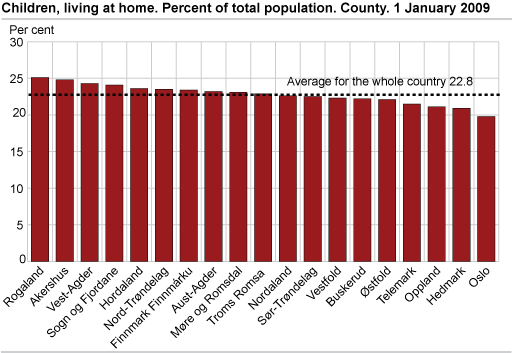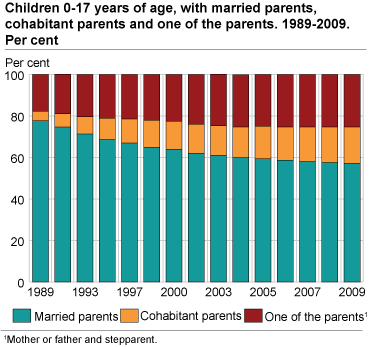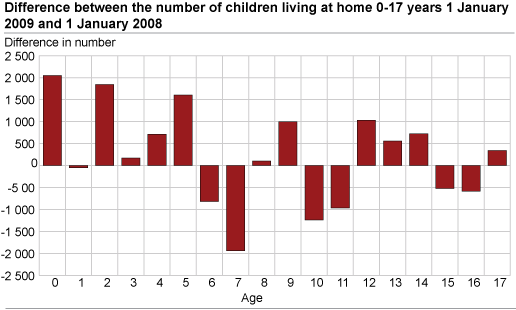Content
Published:
This is an archived release.
One in four are children below 18
At the turn of the year, 1 092 700 children below 18 years of age were living at home in Norway; an increase of 4 000 from the previous year. A total of 23 per cent of the total population are children.
Compared to the total population, Rogaland has the largest proportion of children; one out of four. Akershus has the second highest proportion. There are fewest children compared to the population in the counties of Oslo and Hedmark, where one out of five is a child.
Most children in municipalities in Western Norway
The share of children as a percentage of the population varies in the municipalities, from 29.2 in Fjell in Hordaland, which has the highest share, to 16.8 in Ibestad in Troms, which has the lowest share. Of the ten municipalities with the highest share of children, six are situated in Rogaland. Of the ten with the lowest share, three are situated in Hedmark.
| Most | Fewest | ||||||||||||||||||||||||||||||||||||||
|---|---|---|---|---|---|---|---|---|---|---|---|---|---|---|---|---|---|---|---|---|---|---|---|---|---|---|---|---|---|---|---|---|---|---|---|---|---|---|---|
| 1246 Fjell | 29.2 | 2002 Vardø | 18.9 | ||||||||||||||||||||||||||||||||||||
| 1662 Klæbu | 29.1 | 2023 Gamvik | 18.9 | ||||||||||||||||||||||||||||||||||||
| 1122 Gjesdal | 28.8 | 0622 Krødsherad | 18.9 | ||||||||||||||||||||||||||||||||||||
| 1120 Klepp | 28.6 | 1874 Moskenes | 18.9 | ||||||||||||||||||||||||||||||||||||
| 1142 Rennesøy | 28.6 | 2015 Hasvik | 18.8 | ||||||||||||||||||||||||||||||||||||
| 1127 Randaberg | 28.3 | 1913 Skånland | 18.6 | ||||||||||||||||||||||||||||||||||||
| 1146 Tysvær | 27.9 | 1849 Hamarøy | 18.5 | ||||||||||||||||||||||||||||||||||||
| 1026 åseral | 27.8 | 0423 Grue | 18.3 | ||||||||||||||||||||||||||||||||||||
| 1119 Hå | 27.8 | 1929 Berg | 18.3 | ||||||||||||||||||||||||||||||||||||
| 1256 Meland | 27.7 | 0432 Rendalen | 18.2 | ||||||||||||||||||||||||||||||||||||
| 1247 Askøy | 27.5 | 2017 Kvalsund | 18.1 | ||||||||||||||||||||||||||||||||||||
| 1835 Træna | 27.3 | 0430 Stor Elvdal | 18.0 | ||||||||||||||||||||||||||||||||||||
| 1124 Sola | 27.2 | 0425 åsnes | 17.9 | ||||||||||||||||||||||||||||||||||||
| 1516 Ulstein | 27.2 | 0426 Våler | 17.6 | ||||||||||||||||||||||||||||||||||||
| 1432 Førde | 27.1 | 1928 Torsken | 17.5 | ||||||||||||||||||||||||||||||||||||
| 1114 Bjerkreim | 27.1 | 1839 Beiarn | 17.2 | ||||||||||||||||||||||||||||||||||||
| 1219 Bømlo | 27.0 | 2027 Unjárga Nesseby | 17.2 | ||||||||||||||||||||||||||||||||||||
| 1663 Malvik | 26.8 | 1755 Leka | 17.2 | ||||||||||||||||||||||||||||||||||||
| 2012 Alta | 26.8 | 1724 Verran | 16.9 | ||||||||||||||||||||||||||||||||||||
| 0234 Gjerdrum | 26.8 | 1917 Ibestad | 16.8 | ||||||||||||||||||||||||||||||||||||
4 000 more children in 2008
The number of children below 18 years of age living at home increased by 4 000 in 2008. Approximately half of the increase was due to the increase in the number of births in 2008, amounting to 2 000.
The number of children increased in most age groups last year. The difference in the number of children in each age group from one year to another corresponds to the annual cohort of births. Additionally, in- and out-migration during a year have an influence on the difference from one year to the next.
Steadily more children with cohabiting parents
The development of steadily more children living with cohabiting parents continues, while fewer children live with married parents. Three out of four children in Norway live with both parents; 57 per cent with married parents and somewhat more than 17 per cent with cohabiting parents.
Since 1989, which was the first year the children statistics were published, the share of children below 18 years of age living with married parents has decreased from 78 to 57 per cent. During the same period, the share of children living with cohabiting parents increased from 5 to 17 per cent.
Simultaneously, the proportion of children not living with both parents has increased from 18 to 25 per cent. Among the children registered in the statistics as living only with their mother or father, a fairly large part have two grown-ups at home, because they also live together with a step father or step mother.
One sibling most common
In 2009, somewhat more than 18 per cent, or 201 200 children without siblings were living at home. The share of children without siblings living at home has shown a steady increase since 2001, when the corresponding percentage was 17.
It is most common to live with one sibling. As per 1 January 2009, 44 per cent of all children in Norway lived with one brother or one sister. Somewhat more than one in four lived with two siblings.
About 80 per cent of children who had siblings lived with both their parents, while 54 per cent of children without siblings did the same. Some children have siblings over 18 years of age living at home, or siblings who have left home.
Tables:
- Table 1 Children 0-17 years, by number of parents in the family, the parents' cohabitation arrangements and the child's age. 2001, 2005, 2006, 2007, 2008 and 2009. Per cent
- Table 2 Children 0-17 years, by number of parents in the family, the parents' cohabitation arrangements, siblings living at home and the child's age. 2001, 2005, 2006, 2007, 2008 and 2009
- Table 3 Children 0-17 years, by number of parents in the family, the parents' cohabitation arrangements and county. 2001, 2005, 2006, 2007, 2008 and 2009. Per cent
- Table 4 Children 0-17 år, by type of siblings living at home and the child's age. 2001, 2005, 2006, 2007, 2008 and 2009. Per cent
- Table 5 Children 0-17 år, by type of siblings living at home and county. 2001, 2005, 2006, 2007, 2008 and 2009. Per cent
- Table 6 Children 0-17 years, by number of siblings and parents living at home and the parents' cohabitation arrangements. 2001, 2005, 2006, 2007, 2008 and 2009. Per cent
- Table 7 Children 0-17 years, by number of siblings and county. 2001, 2005, 2006, 2007, 2008 and 2009. Per cent
- Table 8 Children 0-17 years, by number of siblings and the child's age. 2001, 2005, 2006, 2007, 2008 and 2009. Per cent
The statistics is published with Families and households.
Contact
-
Statistics Norway's Information Centre
E-mail: informasjon@ssb.no
tel.: (+47) 21 09 46 42



